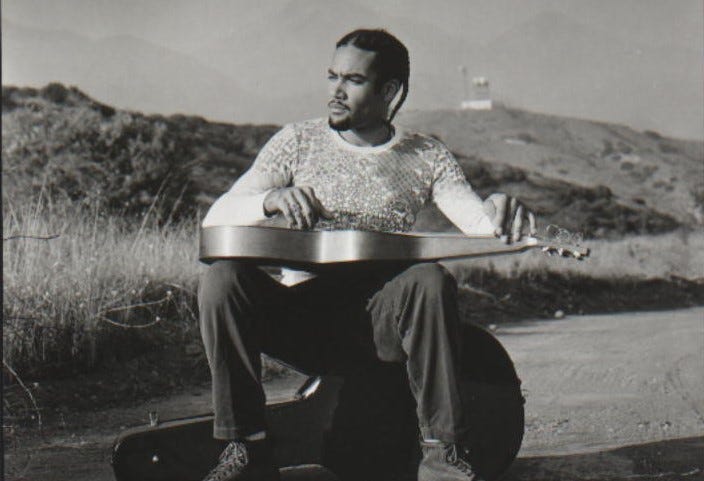Ben Harper: The Complete 1997 “Will to Live” Interview
On Songs, Guitars, Tunings, and “The Strongest Spirit in All Creation”
With his first album, 1994’s Welcome to the Cruel World, Ben Harper revealed himself to be both a forward-looking singer/songwriter and a passionate advocate for roots American music from bygone eras. For starters, he conjured his lonesome, overtone-laden slide sound on a Style 4 Hawaiian koa guitar built by Herman Weissenborn during the 1920s. His playing technique, with the guitar held flat on his lap, harkened to the Hawaiian musicians of the early 20th century and the very first recordings of blues guitar.
With slide songs such as “Whipping Boy,” Harper seemed to conjure the spirit of Blind Willie Johnson, whom he readily acknowledged as his primary musical inspiration: “That’s it,” Ben confirmed when I asked him about it soon after the album’s release. “When I’m sleeping, I hear Blind Willie Johnson. I hear him all the time. My other heroes are Blind Willie McTell, Robert Johnson, Taj Mahal, Lowell George – oh, man! – and Chris Darrow, who played with David Lindley. And even great rhythm players, like Bob Marley, with his chunk rhythm heartbeat, and Jimi Hendrix – God, all day, you know?”
Ben, born in 1969, grew up surrounded by music. His family owned the Folk Music Center music store in Claremont, California, and his grandparents weaned him on their collection of blues 78s. After some musical experimentation, at age sixteen he found the technique that suited him best. “I found I was able to express myself on slide guitar,” he recalled. “I started playing bottleneck a lot – I still do – but the attack and the sound I was trying to attain used a different musical formation, so I switched to playing lap-style.” He invented his own tunings, which he was guarded about during his first interviews. Before signing with Virgin Records, Ben sharpened his playing in Taj Mahal’s road band.
In our 1994 interview, Ben, who’d just finished recording Welcome to the Cruel World, was guarded about his recording techniques and the open tunings he used for slide. This was not the case when we had our next interview, on June 5, 1997. At the time of this conversation, he was celebrating the release of his third album, The Will to Live.
###
You have an uplifting message in a lot of your music.
Thank you for feeling that. It’s nice to be behind the guitar in that spirit.
To me, a song like “Homeless Child” has everything that made “Rollin’ and Tumblin’” great.
Ah, bless your heart!
I hear it coming out of that spirit of “get in the trance and ride that lick as far as you can” kind of music, especially with that jangly background rhythm. It’s almost like that old Eddie Head music, “Lord, I’m the True Vine,” and those other songs from the 1930s.
Absolutely. You know how hard it is to bring something new to roots blues. I mean, what’s brought to blues and the spirit of blues today is really nothing but bar-room. And the bar-room blues, for me, just doesn’t move my heart. And so it’s been a huge challenge and it’s the first time I feel strongly that I’m bringing a contribution to the blues. And I hope I have done the spirit of roots blues music justice through that song. I mean, I write a lot of blues songs and Jas, I gotta tell you: I put ’em away. They haven’t been strong enough and I just set them aside and I use the lyrics from the blues songs for other songs and things. And I feel privileged to have written a song that, from your words, reaffirms my feeling of contributing to that spirit and not taking from it.
Keep reading with a 7-day free trial
Subscribe to Talking Guitar ★ Jas Obrecht's Music Magazine to keep reading this post and get 7 days of free access to the full post archives.



